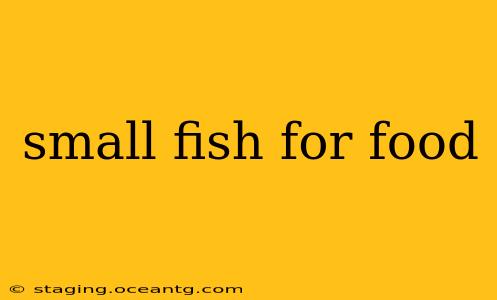Small fish play a vital role in the marine ecosystem and are also a significant source of protein and nutrients for humans worldwide. Choosing the right small fish for food involves understanding sustainability, nutritional value, and responsible sourcing. This guide explores these crucial aspects, helping you make informed decisions about incorporating small fish into your diet.
What are some examples of small fish used for food?
Many small fish species are consumed globally. Popular examples include anchovies, sardines, herring, sprats, and menhaden. These fish are often found in large schools and are relatively easy to catch, making them an important food source for both humans and other marine animals. Their nutritional value is also considerable, as detailed below. Regional variations exist; for example, in some parts of the world, small species of cod or other whitefish might be commonly consumed.
Are small fish healthy to eat?
Yes, small fish are generally considered very healthy to eat. They are packed with essential nutrients, including:
- Omega-3 fatty acids: These healthy fats are crucial for heart health, brain function, and reducing inflammation. Small oily fish like sardines and anchovies are particularly rich in omega-3s.
- Protein: Small fish are an excellent source of high-quality protein, essential for building and repairing tissues.
- Vitamins and minerals: They are a good source of vitamins like vitamin D and B vitamins, as well as minerals like calcium, iron, and selenium.
The nutritional profile can vary slightly depending on the species and its environment, but overall, small fish offer a diverse range of essential nutrients.
What are the environmental impacts of fishing for small fish?
The environmental impact of small fish fishing is complex and varies greatly depending on fishing methods and management practices. Unsustainable fishing practices can deplete fish stocks, damage habitats, and lead to bycatch (the accidental capture of non-target species). However, many small fish species are highly productive and can sustain relatively high fishing pressure if managed properly. Sustainable fishing practices, such as using selective gear and avoiding overfishing, are crucial to minimizing environmental impacts. Look for certifications like the Marine Stewardship Council (MSC) label when purchasing small fish to ensure they come from sustainably managed fisheries.
Are there sustainable ways to eat small fish?
Absolutely! Choosing sustainably sourced small fish is key to ensuring their long-term availability and protecting marine ecosystems. Here are some tips:
- Look for certifications: Seek out fish with MSC certification, indicating sustainable fishing practices.
- Choose locally sourced fish: Buying locally reduces transportation impacts and supports local fisheries.
- Consider the species: Research the sustainability of different species before purchasing.
- Reduce your overall consumption of seafood: This helps to reduce pressure on all fish populations, including small fish.
How can I prepare small fish?
Small fish can be prepared in numerous delicious and easy ways. Popular methods include:
- Baking: Baking small whole fish is a simple and healthy cooking method.
- Frying: Pan-frying or deep-frying can create crispy and flavorful results.
- Grilling: Grilling adds a smoky char to the fish.
- Adding to sauces or stews: Small fish can add depth and flavor to many dishes.
By making conscious choices about the types of small fish you consume and how you source them, you can enjoy their nutritional benefits while contributing to the sustainability of our oceans. Remember that responsible consumption and supporting sustainable fishing practices are key to ensuring that these vital resources are available for generations to come.
